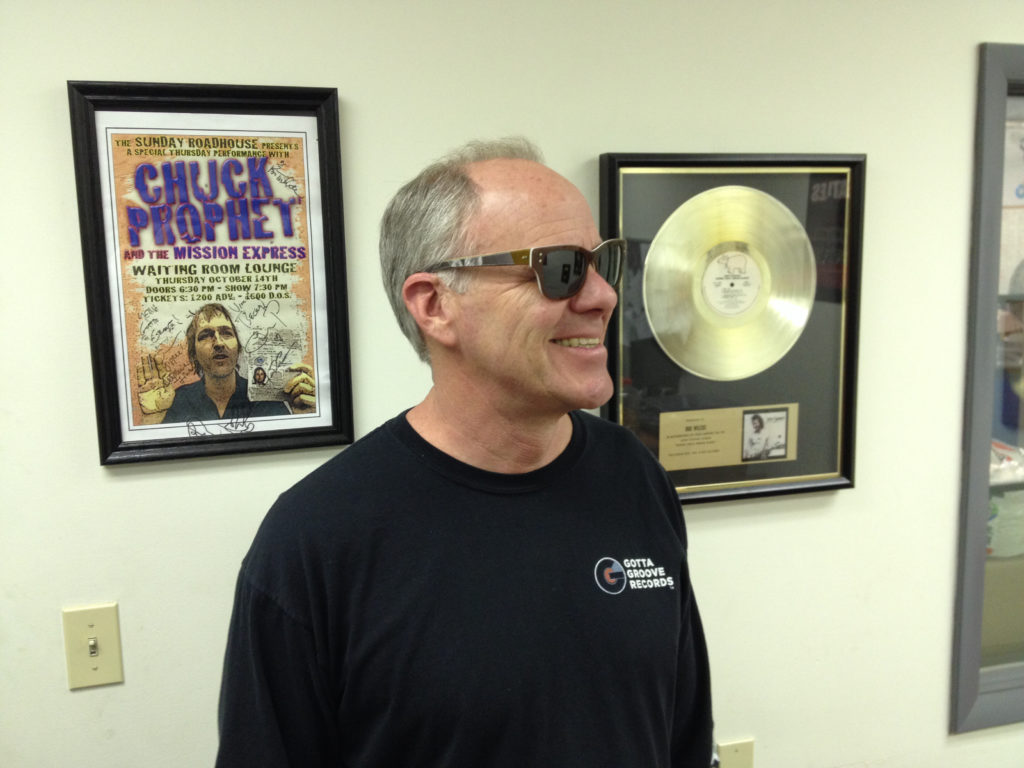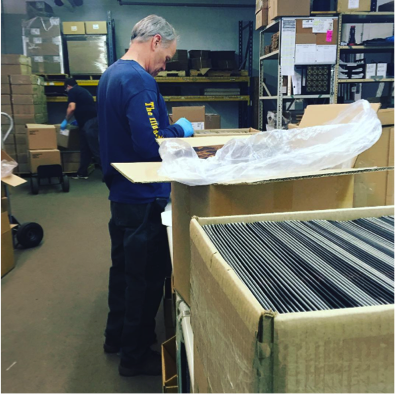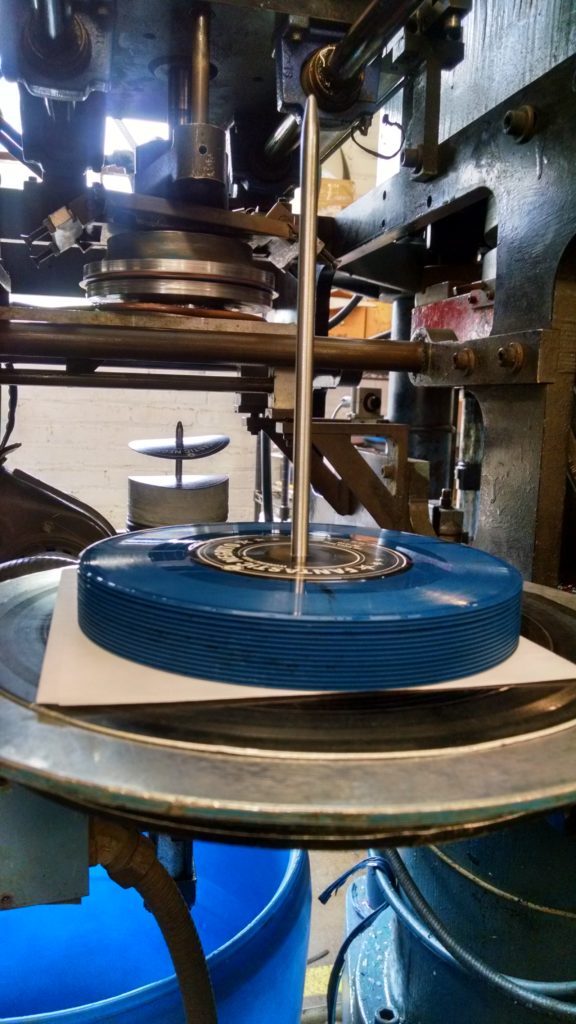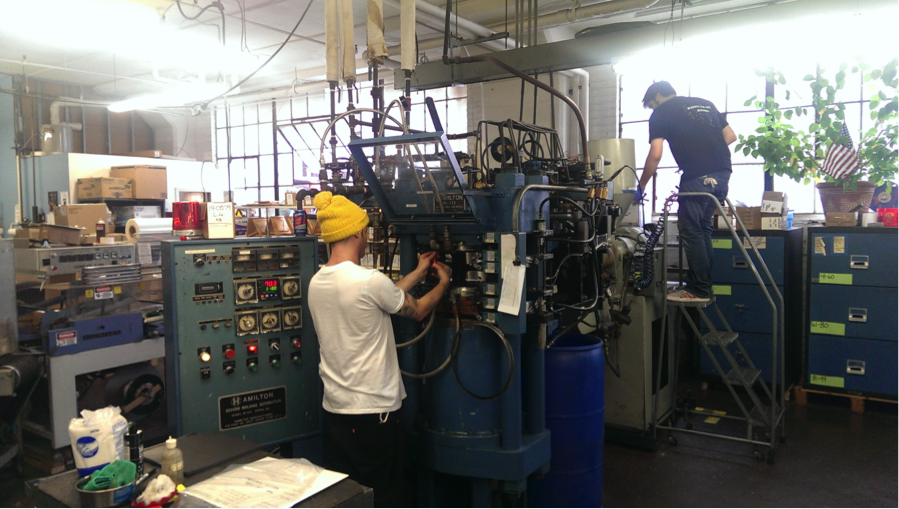[caption id="attachment_3422" align="alignright" width="328"] Photo Courtesy of Gotta Groove Records[/caption]
As record sales continue to rise, Record Pressing Plants are expanding across the country to handle the unexpected consumer demand for music in the vinyl format. One such plant is A-T’s own Ohioan neighbor, Gotta Groove Records in Cleveland, which has the distinction of being the world’s first completely vertically integrated vinyl manufacturing and distribution operation.
We caught up with the owner of Gotta Groove Records, Vince Slusarz, and its Vice-President of Sales and Marketing, Matt Earley, to discuss the intricate process of how vinyl is made and why the format has endured for so many years.
Audio-Technica: The vinyl revival was still in its infancy when you opened in 2009. What inspired you to get into the vinyl business?
Vince Slusarz: I had a desire to start a manufacturing business from scratch, with the goal of establishing it in Cleveland. I have always loved and collected vinyl, and when it became apparent that vinyl record sales were beginning to increase (along with seeing my then 23-year-old daughter buying records) I decided to jump in.
A-T: As a longtime record collector, where did your passion for vinyl come from? Do you remember the first record you ever owned?
Slusarz: Music has been a key source of pleasure for as long as I can remember and growing up in the late sixties and early seventies, vinyl was the main medium for listening to it. The first LP I bought was in 1969 - Tommy James and the Shondells Crimson and Clover.
[caption id="attachment_3423" align="alignleft" width="293"]
Photo Courtesy of Gotta Groove Records[/caption]
As record sales continue to rise, Record Pressing Plants are expanding across the country to handle the unexpected consumer demand for music in the vinyl format. One such plant is A-T’s own Ohioan neighbor, Gotta Groove Records in Cleveland, which has the distinction of being the world’s first completely vertically integrated vinyl manufacturing and distribution operation.
We caught up with the owner of Gotta Groove Records, Vince Slusarz, and its Vice-President of Sales and Marketing, Matt Earley, to discuss the intricate process of how vinyl is made and why the format has endured for so many years.
Audio-Technica: The vinyl revival was still in its infancy when you opened in 2009. What inspired you to get into the vinyl business?
Vince Slusarz: I had a desire to start a manufacturing business from scratch, with the goal of establishing it in Cleveland. I have always loved and collected vinyl, and when it became apparent that vinyl record sales were beginning to increase (along with seeing my then 23-year-old daughter buying records) I decided to jump in.
A-T: As a longtime record collector, where did your passion for vinyl come from? Do you remember the first record you ever owned?
Slusarz: Music has been a key source of pleasure for as long as I can remember and growing up in the late sixties and early seventies, vinyl was the main medium for listening to it. The first LP I bought was in 1969 - Tommy James and the Shondells Crimson and Clover.
[caption id="attachment_3423" align="alignleft" width="293"] Photo Courtesy of Gotta Groove Records[/caption]
A-T: You’ve had the opportunity to work with hundreds of artists, from Blue Oyster Cult to Fleetwood Mac. What do you think drives artists to choose Gotta Groove?
Earley: We pride ourselves on being “the artist’s preferred pressing plant.” I believe that this tagline plays out in reality because of the extra attention to detail that we place on every order, no matter how large or small the order quantity may be. Vinyl is not perfect, but we try to get it as close to perfect as it can be. This often requires spending extra time on certain aspects of a project – whether it be on the actual audio masters, the cycle times during pressing, or even the printed artwork. While this may mean we press fewer records on any given day, the records that do leave our plant are of the highest quality they possibly could be for the format.
A-T: Can you tell us about the process involved in manufacturing vinyl?
Slusarz: The most common question we get is “How does the music get on there?” Typically the process breaks down as follows:
Step 1- The music file or tape is cut by a lathe on an aluminum disc coated with lacquer-some people refer to this as the “master”- this is how the music eventually gets on the vinyl record.
Step 2- The lacquer is sprayed with a silver solution to create a “Mother” -essentially a metal replication of the lacquer.
Photo Courtesy of Gotta Groove Records[/caption]
A-T: You’ve had the opportunity to work with hundreds of artists, from Blue Oyster Cult to Fleetwood Mac. What do you think drives artists to choose Gotta Groove?
Earley: We pride ourselves on being “the artist’s preferred pressing plant.” I believe that this tagline plays out in reality because of the extra attention to detail that we place on every order, no matter how large or small the order quantity may be. Vinyl is not perfect, but we try to get it as close to perfect as it can be. This often requires spending extra time on certain aspects of a project – whether it be on the actual audio masters, the cycle times during pressing, or even the printed artwork. While this may mean we press fewer records on any given day, the records that do leave our plant are of the highest quality they possibly could be for the format.
A-T: Can you tell us about the process involved in manufacturing vinyl?
Slusarz: The most common question we get is “How does the music get on there?” Typically the process breaks down as follows:
Step 1- The music file or tape is cut by a lathe on an aluminum disc coated with lacquer-some people refer to this as the “master”- this is how the music eventually gets on the vinyl record.
Step 2- The lacquer is sprayed with a silver solution to create a “Mother” -essentially a metal replication of the lacquer. Step 3- The Mother is placed in an electroplating nickel bath and a “Stamper” is formed. It is a mirror image of the Mother, which means the grooves on the Stamper are raised.
This metal plating is a two-step process (Mother to Stamper). For large runs of 10,000 records or more, a three-step process is often employed- a Father is first created, which can then begat numerous Mothers and subsequently, Stampers.
Step 4- Record labels are physically pressed into the records, not glued. The heat of the press can release the ink in the labels and cause scrap, so labels need to be dried in an oven before pressing.
Step 5- An extruder attached to the Compression Molding Press melts vinyl pellets and pushes the vinyl into a form called a “Biscuit” or a “Puck.” The labels are applied to the Biscuit, which then goes forward into the press. The A-side stamper is affixed to a bottom die, and the B-side to the top die. The press slowly closes while the dies are heated with steam up to 300° F. The vinyl melts, filling the grooves and extending beyond the first groove by around a ½ inch (this section is called the “flash”). Once filled, the dies are then flushed with cold water to stiffen the record. This step takes anywhere from 30-45 seconds per record.
Step 6- The press opens and the record drops on a trimmer table; the flash is then trimmed off and the record is dropped on the stack of the records previously pressed.
Step 7- The records are removed from the stack and taken by our Quality Assurance (“QA”) personnel to one of our three QA rooms for audio review.
Step 8- The approved records are taken to packaging, where they further cool on a shelf. They are then packaged and shipped per the customer’s specifications.
While not part of our process, it is important to recognize that the most important step in making a quality sounding record is in the initial recording and engineering mastering process. Ideally, recordings should be mastered for vinyl, as opposed to CD.
[caption id="attachment_3424" align="aligncenter" width="601"]
Step 3- The Mother is placed in an electroplating nickel bath and a “Stamper” is formed. It is a mirror image of the Mother, which means the grooves on the Stamper are raised.
This metal plating is a two-step process (Mother to Stamper). For large runs of 10,000 records or more, a three-step process is often employed- a Father is first created, which can then begat numerous Mothers and subsequently, Stampers.
Step 4- Record labels are physically pressed into the records, not glued. The heat of the press can release the ink in the labels and cause scrap, so labels need to be dried in an oven before pressing.
Step 5- An extruder attached to the Compression Molding Press melts vinyl pellets and pushes the vinyl into a form called a “Biscuit” or a “Puck.” The labels are applied to the Biscuit, which then goes forward into the press. The A-side stamper is affixed to a bottom die, and the B-side to the top die. The press slowly closes while the dies are heated with steam up to 300° F. The vinyl melts, filling the grooves and extending beyond the first groove by around a ½ inch (this section is called the “flash”). Once filled, the dies are then flushed with cold water to stiffen the record. This step takes anywhere from 30-45 seconds per record.
Step 6- The press opens and the record drops on a trimmer table; the flash is then trimmed off and the record is dropped on the stack of the records previously pressed.
Step 7- The records are removed from the stack and taken by our Quality Assurance (“QA”) personnel to one of our three QA rooms for audio review.
Step 8- The approved records are taken to packaging, where they further cool on a shelf. They are then packaged and shipped per the customer’s specifications.
While not part of our process, it is important to recognize that the most important step in making a quality sounding record is in the initial recording and engineering mastering process. Ideally, recordings should be mastered for vinyl, as opposed to CD.
[caption id="attachment_3424" align="aligncenter" width="601"] Photo Courtesy of Gotta Groove Records[/caption]
A-T: What an incredible process! Now we know that you also produce colored vinyl, is that production process different than when manufacturing traditional black vinyl?
Slusarz: In general, the process is the same. Where it can differ is the requested color- if not a stock color, we have to blend colors by hand ahead of time and add the blend to the hopper feeding the extruder. If it’s a specialty color effect- such as a ½ and ½ split or splatter, it requires an extra outside operation to achieve the effect and a dedicated press operator.
A-T: GGR now has the distinction of being the world’s first completely vertically integrated vinyl manufacturing and distribution operation. Why was it important to handle this entire process in house?
Earley: Admittedly, making records is not easy. There are many different considerations – some of which may compete with one another – in the mastering, art preparation, vinyl color/weight, runtime, and even marketing of any given record.
Beyond striving to make the highest quality records possible, one of our main goals from the beginning was to make getting records to market as easy as possible. By having the resources to handle every part what goes into making and selling records under one roof, so to speak, we are able to dramatically simplify the process. We believe we have helped more records come to market that may not otherwise have seen the light of day, by being able to walk our customers through the various parts in the supply chain.
A-T: You mentioned that providing a high quality product is one of GGR’s hallmarks. What kind of quality control procedures do you have in place?
Earley: During plating, we continually monitor the stampers while pressing records and replace as necessary. Sometimes this means changing stampers out multiple times in a single job (and, most commonly, this is at our expense). But, we do what it takes to ensure that each record in a given run is produced as best as it can be.
Records we plate in-house via our plating partnership with QCA, Inc. are processed using a combination of proprietary materials and procedures. To avoid issues with “shelf bought” chemicals, we mix all of the chemicals used in the process in our own facility. We plate lacquers at lower amperage than many electroforming professionals. While this means masters/mothers/stampers take longer to create, they tend to be truer to the frequency response of the original lacquer cut than faster-speed plating can reproduce.
On the pressing side of things, one of the key differences with our plant vs others in the industry is our QA operation – many folks are surprised to hear that we have employees listening to parts of approximately every 25th record off each press. As you can imagine, this does require quite a bit of resources. However, we are continually convinced that we catch and control many quality issues that would otherwise make it to market if our extensive QA operation were not in place.
Photo Courtesy of Gotta Groove Records[/caption]
A-T: What an incredible process! Now we know that you also produce colored vinyl, is that production process different than when manufacturing traditional black vinyl?
Slusarz: In general, the process is the same. Where it can differ is the requested color- if not a stock color, we have to blend colors by hand ahead of time and add the blend to the hopper feeding the extruder. If it’s a specialty color effect- such as a ½ and ½ split or splatter, it requires an extra outside operation to achieve the effect and a dedicated press operator.
A-T: GGR now has the distinction of being the world’s first completely vertically integrated vinyl manufacturing and distribution operation. Why was it important to handle this entire process in house?
Earley: Admittedly, making records is not easy. There are many different considerations – some of which may compete with one another – in the mastering, art preparation, vinyl color/weight, runtime, and even marketing of any given record.
Beyond striving to make the highest quality records possible, one of our main goals from the beginning was to make getting records to market as easy as possible. By having the resources to handle every part what goes into making and selling records under one roof, so to speak, we are able to dramatically simplify the process. We believe we have helped more records come to market that may not otherwise have seen the light of day, by being able to walk our customers through the various parts in the supply chain.
A-T: You mentioned that providing a high quality product is one of GGR’s hallmarks. What kind of quality control procedures do you have in place?
Earley: During plating, we continually monitor the stampers while pressing records and replace as necessary. Sometimes this means changing stampers out multiple times in a single job (and, most commonly, this is at our expense). But, we do what it takes to ensure that each record in a given run is produced as best as it can be.
Records we plate in-house via our plating partnership with QCA, Inc. are processed using a combination of proprietary materials and procedures. To avoid issues with “shelf bought” chemicals, we mix all of the chemicals used in the process in our own facility. We plate lacquers at lower amperage than many electroforming professionals. While this means masters/mothers/stampers take longer to create, they tend to be truer to the frequency response of the original lacquer cut than faster-speed plating can reproduce.
On the pressing side of things, one of the key differences with our plant vs others in the industry is our QA operation – many folks are surprised to hear that we have employees listening to parts of approximately every 25th record off each press. As you can imagine, this does require quite a bit of resources. However, we are continually convinced that we catch and control many quality issues that would otherwise make it to market if our extensive QA operation were not in place.
 A-T: Your facility uses two fully restored Neumann VMS-70 lathes, how did you acquire these vintage machines?
Earley: The lathes are owned and operated by our master lacquer engineer, Clint Holley (the name of his studio is Well Made Music). Clint was fortunate enough to acquire these machines at the same time that we were just about to launch our pressing plant.
A-T: As we wrap up our interview, let’s discuss vinyl as a medium. Why do you think it has endured for so long? What does it offer that other formats don’t?
Earley: Vinyl is the last physical medium for music (and, ironically, vinyl’s basic technology was the first physical music medium as well). Seemingly, it would be very unlikely for another physical medium to be invented at this point, which would become the dominant medium for music consumption.
To clarify – this is not to suggest vinyl is, or will become, the dominant medium for music consumption – digital (mainly streaming) wears the convenience hat. But, vinyl is unique in that it forces the listener to take the time necessary to pay attention to the recording. Reel-to-reel tape has excellent sound quality, but purchasing and maintaining a tape deck and tapes is far more complicated than vinyl/turntables for the majority of people. Digital does not offer the intimate listening experience of setting one’s stylus and flipping the record at the end of the side. Essentially having direct control over sound via the cartridge used, the turntable, the preamp, etc.
No other medium beyond vinyl exists – physical or digital – that is both accessible to a wide span of technical aptitude and budget, and intimately brings the listener’s attention to the program material. And, the artful packaging and reader-friendly text makes for an even more tactile experience. For this reason, vinyl will endure as long as there are people who desire a more personal approach to listening to music.
A-T: Your facility uses two fully restored Neumann VMS-70 lathes, how did you acquire these vintage machines?
Earley: The lathes are owned and operated by our master lacquer engineer, Clint Holley (the name of his studio is Well Made Music). Clint was fortunate enough to acquire these machines at the same time that we were just about to launch our pressing plant.
A-T: As we wrap up our interview, let’s discuss vinyl as a medium. Why do you think it has endured for so long? What does it offer that other formats don’t?
Earley: Vinyl is the last physical medium for music (and, ironically, vinyl’s basic technology was the first physical music medium as well). Seemingly, it would be very unlikely for another physical medium to be invented at this point, which would become the dominant medium for music consumption.
To clarify – this is not to suggest vinyl is, or will become, the dominant medium for music consumption – digital (mainly streaming) wears the convenience hat. But, vinyl is unique in that it forces the listener to take the time necessary to pay attention to the recording. Reel-to-reel tape has excellent sound quality, but purchasing and maintaining a tape deck and tapes is far more complicated than vinyl/turntables for the majority of people. Digital does not offer the intimate listening experience of setting one’s stylus and flipping the record at the end of the side. Essentially having direct control over sound via the cartridge used, the turntable, the preamp, etc.
No other medium beyond vinyl exists – physical or digital – that is both accessible to a wide span of technical aptitude and budget, and intimately brings the listener’s attention to the program material. And, the artful packaging and reader-friendly text makes for an even more tactile experience. For this reason, vinyl will endure as long as there are people who desire a more personal approach to listening to music.
Do you remember when you first fell in love with vinyl? Tell us in the comments below or on Twitter @USAudioTechnica!